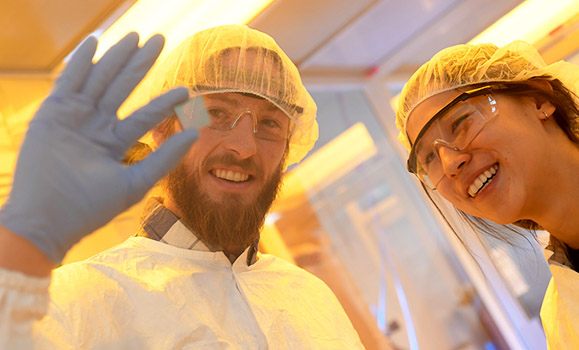Perovskites, once on the fringes of solar cell research, have fast become the “it” materials for advancing solar power.
The golden ticket for successful solar cell technology is efficiency: the amount of sunlight a solar cell can convert to electricity. With perovskites — a particular type of crystal-structured materials — scientists have been able make solar cells with efficiencies of 22 per cent, up from about 3 per cent in just a few years. That kind of surge in efficiency is unlike any other material in the history of solar cell technology. That perovskites are poised to be low cost and easy to integrate into infrastructure makes them a game changer for the future of clean energy.
Excitement around organometal halide perovskite, the kind used in solar cells, is hard to miss among those in the field. But fundamental understanding of this mysterious material — and why it works so well — is limited.
Today (Thursday, December 15), Scientific Reports .
“We’ve used a technique that hasn’t been applied to these materials before,” says , lead author of the study and Canada Research Chair in Ultrafast Science.
Ultrafast lasers and spectroscopy
Drs. Hall and colleague Ian Hill, with their team of graduate students from the Department of Physics and Atmospheric Science, used four wave mixing spectroscopy to study organometal halide perovskite. This technique, together with the application of ultrafast laser technology, allowed the team to observe what happens within a few femtoseconds — one quadrillionth of a second — after light is absorbed into the material.
The team was particularly interested in particles called excitons: electrons in an excited but bound state, as if “stuck” in an atom. But electrons have to be able to flow freely in a material to create a current that can be harvested for electricity. In perovskites, the bound electrons are eventually knocked free, allowing the electrical current necessary for a functioning solar cell.
 “How hard it is to rip this electron away is a very important quantity and characteristic of a solar cell,” says Dr. Hall (left). “Unless you can break this thing apart with a pretty small amount of energy, you can’t make current.”
“How hard it is to rip this electron away is a very important quantity and characteristic of a solar cell,” says Dr. Hall (left). “Unless you can break this thing apart with a pretty small amount of energy, you can’t make current.”
The energy responsible for freeing an electron is called the “exciton binding energy.” Previous attempts to measure it have ended in contradicting results. Perovskites are very easy to make, which is why they are low in cost, but they also have a lot of defects within their chemical makeup. These defects make it difficult to accurately measure a variety of material properties, including the binding energy.В В
Using their ultrafast lasers, the Dal research team was able to sift through the mess and differentiate defect-bound excitons from others. They’ve provided the clearest picture of exciton binding energy within perovskites to date.
Despite the defects, perovskite efficiency is still remarkable. Dr. Hill and Dr. Hall note the current industry standard silicon solar cell would never work as well with that many defects.
A key contribution to the field
The study, says Dr. Hill, clarifies the current body of literature examining perovskites.
“We’re able to not only get a more accurate measurement, but to understand more about why there were these discrepancies in the literature,” says , physics professor and associate vice-president research at Dal.
Solar cell researchers will continue to explore this superstar material, and knowing the value of exciton binding energy will help them improve its design even further.
“Why do they work so well with these defects? Can we make other materials that would work similarly?” asks Dr. Hill. “To do that, we have to first understand how the charges behave and that’s why this work is so fundamental.”
Possible applications could see perovskites combined with silicon solar cells to create the highest efficiencies yet — higher than any one material is capable of on its own. Doing so would be developing what’s called a multi-junction solar cell. (It’s possible to make these solely with traditional materials, but they’re so expensive that their use is limited to high-end satellites.)

Doctoral students Sam Marsh and Charlotte Clegg, here in Dr. Ian Hill’s lab, have co-founded a spin-off company after working on this study.
In the meantime, Sam March and Charlotte Clegg, PhD students with Dr. Hall and Dr. Hill respectively, are in the process of starting up Rayleigh Solar Tech. It’s a Canadian company based in Nova Scotia that aims to address the remaining barriers of large-scale perovskite solar cell production to boost the up-and-coming technology. Jon-Paul Sun, another PhD student not involved in this study, is also a co-founder.
"We realized that we have a unique opportunity to help bring this potentially revolutionary technology to market,” says March.
This new research and spin-off company bring us a few steps closer to a future of more affordable solar power generation throughout the world.

